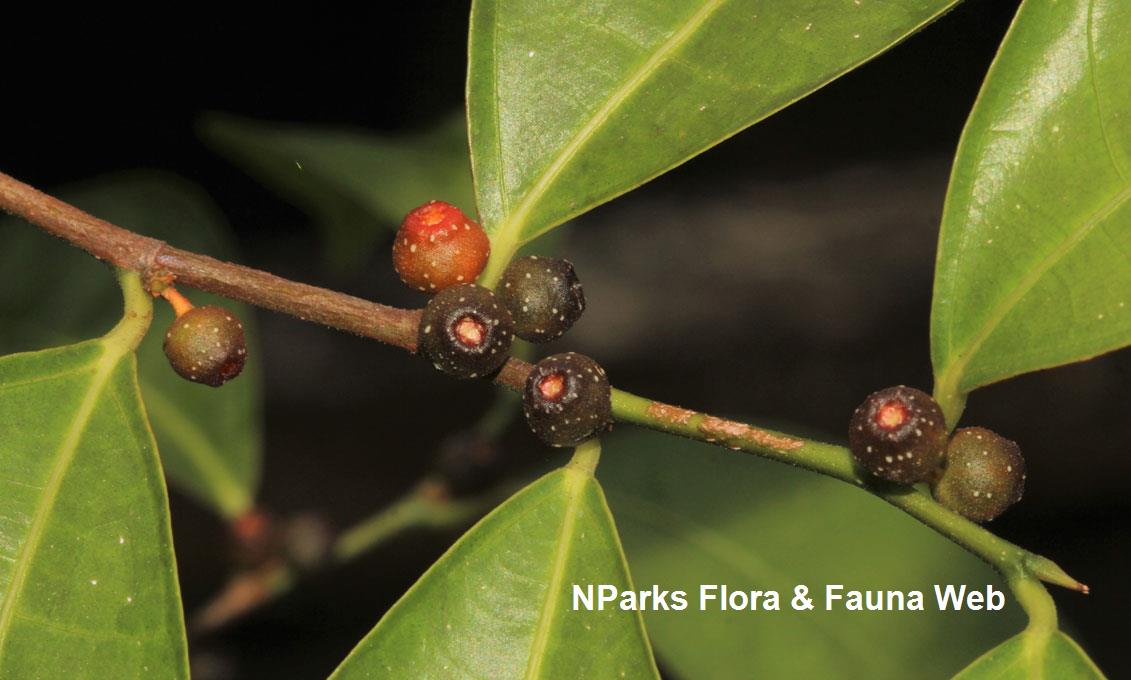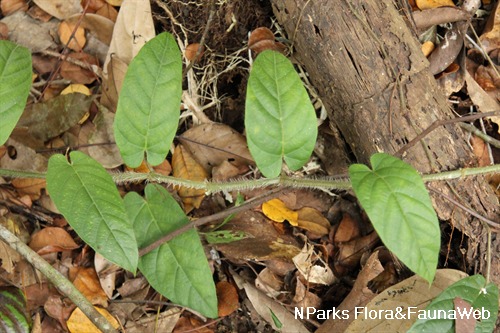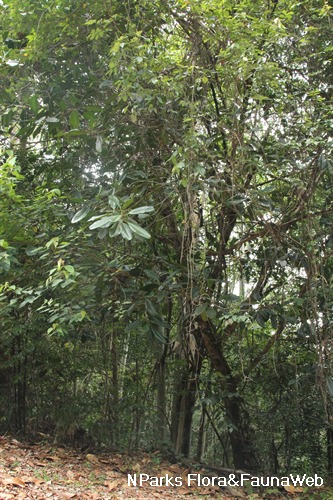.jpg)
Back
Ficus sinuata Thunb.
| Family Name: | Moraceae |
| Synonyms: | Ficus rostrata Lam. |
Ficus sinuata is a shrub or small tree up to 6 m tall with drooping branches. The leaves are variable in shapes, bristles found sparsely scattered along the veins on the underside. The basal vein run parallel to the margin, 1/8 to 1/4 of the length of the blade. Occurring in clusters underneath the foliage, the figs are almost round to elliptic, and turning orange to red upon maturity.
Name
Classifications and Characteristics
| Plant Division | Angiosperms (Flowering Seed Plants) (Dicotyledon) |
|---|---|
| Plant Growth Form | Shrub, Tree (Shrubby (1m-5m), Small (6m-15m)) |
| Lifespan (in Singapore) | Perennial |
| Mode of Nutrition | Autotrophic |
| Maximum Height | 6 m |
Biogeography
| Native Distribution | Northeast India to Thailand, Sumatra (including Riau Archipelago), Malay Peninsula, Java, Borneo, Singapore |
|---|---|
| Native Habitat | Terrestrial (Primary Rainforest, Secondary Rainforest) |
| Preferred Climate Zone | Tropical, Sub-Tropical / Monsoonal |
| Local Conservation Status | Native to Singapore (Critically Endangered (CR)) |
Description and Ethnobotany
| Growth Form | It is a shrub or small tree that grows to 6 m tall with drooping branches. It often starts of as an epiphyte or epilithic (growing on rocks) before taking roots on the ground. |
|---|---|
| Foliage | The leaves are leathery, slightly irregular in appearance, comes in a range of shapes; oblong, elliptic, spoon to lance-shaped, and measuring 4 - 26 cm long by 1.5 - 10 cm wide. The upper surface of the leaf is smooth while stiff hairs (hispid) are sparsely scattered along the veins on the underside. Each leaf has 6 - 10 (- 17) pairs of lateral veins. The lowest most veins are slightly different from the other pairs. Most lateral veins are 45° to 90° away from the midrib whereas the basal veins run close and almost parallel to the margin, about 1/8 to 1/4 the length of its leaf blade. |
| Flowers | Flowers are entirely enclosed inside the synconium which is also known as a fig. Each fig contains hundreds of tiny flowers. |
| Fruit | The figs are produced underneath the leaves, along the axils. They are produced in clusters on spurs, occasionally singly or in pairs. The figs are almost round to elliptic, about 0.3 - 0.8 cm in diameter, and turning orange to red upon maturity. |
| Habitat | It occurs in forests at altitudes up to 1700 m. <1> |
| Cultivation | It can be propagated by seed. |
Fauna, Pollination and Dispersal
| Pollination Method(s) | Biotic (Fauna) (Insects (Ant, Beetle, Fly, Thrip, Wasp)) |
|---|
Plant Care and Propagation
| Light Preference | Full Sun |
|---|---|
| Water Preference | Moderate Water |
| Plant Growth Rate | Moderate |
| Rootzone Tolerance | Fertile Loamy Soils, Moist Soils, Well-Drained Soils |
| Propagation Method | Seed |
Foliar
| Foliage Retention | Evergreen |
|---|---|
| Mature Foliage Colour(s) | Green |
| Mature Foliage Texture(s) | Glossy / Shiny |
| Foliar Type | Simple / Unifoliate |
| Foliar Arrangement Along Stem | Alternate |
| Foliar Attachment to Stem | Petiolate |
| Foliar Shape(s) | Non-Palm Foliage (Elliptical, Lanceolate, Oblong, Obovate) |
| Foliar Venation | Recticulate |
| Foliar Margin | Crenate, Dentate, Entire |
| Foliar Apex - Tip | Acuminate, Caudate |
| Foliar Base | Cuneate, Oblique / Asymmetrical, Rounded / Obtuse |
Non - Foliar and Storage
| Stem Type & Modification | Woody |
|---|
Floral (Angiosperm)
| Flower & Plant Sexuality | Unisexual Flowers , Dioecious |
| Flower Grouping | Cluster / Inflorescence |
|---|
| Flower Location | Axillary |
| Inflorescence Type | Syconium |
| Flowering Habit | Polycarpic |
Fruit, Seed and Spore
| Mature Fruit Colour(s) | Orange, Red |
|---|---|
| Fruit Classification | Simple Fruit |
| Fruit Type | Fleshy Fruit , Multiple Syconium (receptacle) |
References
| References | <1> Berg, C.C. & Corner, E.J.H. (2005). Ficus. In: Berg, C.C. & Corner, E.J.H. (eds) Moraceae: Ficeae. Flora Malesiana, ser. 1, Seed Plants, vol. 17, pt. 2, pp. 288 - 289. Leiden: Rijksherbarium. |
|---|
Image Repository
Others
| Master ID | 33869 |
|---|---|
| Species ID | 8285 |
| Flora Disclaimer | The information in this website has been compiled from reliable sources, such as reference works on medicinal plants. It is not a substitute for medical advice or treatment and NParks does not purport to provide any medical advice. Readers should always consult his/her physician before using or consuming a plant for medicinal purposes. |

.jpg)
.jpg)




.jpg)